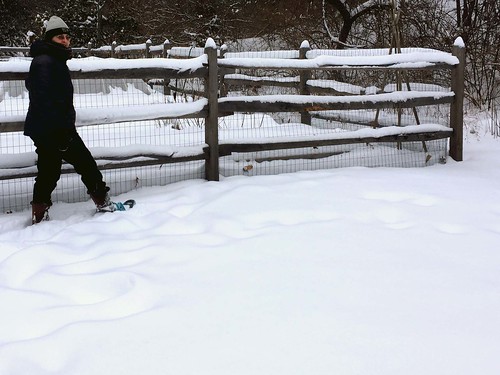This is a journal of my vegetable gardens. Skippy was my first dog and he thought the garden was his, even though I did all the work. Now Suzie and Charley follow in his footsteps. We're located near Boston (USDA zone 6A). I have a community plot, a backyard vegetable garden, fruit trees, berry bushes, chickens, and bees. I use sustainable organic methods and do my best to grow all of my family's vegetables myself.
peas planted!
▼
Friday, February 24, 2017
Thursday, February 23, 2017
it's time to plant onions!
I sowed my first seeds of the season. A tray with several types of onions, leeks, and celeriac. My planting calendar said it was time.


I couldn't find my leftover plant labels from last year, so I cut up a plastic tofu container. I'll get better labels before I need to mark the rows outside.
I'll start up a post soon with a list of the onion varieties I planted. I'll continue fill in this list as I plant more seeds. Next on my planting schedule are cabbages and escarole, but that's not for another two weeks. Until then I'll just watch my onions germinate. (That usually takes 7-10 days.)


I couldn't find my leftover plant labels from last year, so I cut up a plastic tofu container. I'll get better labels before I need to mark the rows outside.
I'll start up a post soon with a list of the onion varieties I planted. I'll continue fill in this list as I plant more seeds. Next on my planting schedule are cabbages and escarole, but that's not for another two weeks. Until then I'll just watch my onions germinate. (That usually takes 7-10 days.)
Wednesday, February 22, 2017
winter walk
The temperatures have been so nice and warm here the past week. Suzie, Charley, and I had a great walk yesterday. We walked around the fields of a small CSA farm, around the empty greenhouse, piled tomato stakes, and dried stalks of corn and Brussels sprouts. The dogs got all muddy - that's the trade off for warm weather.

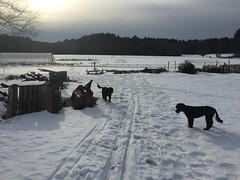

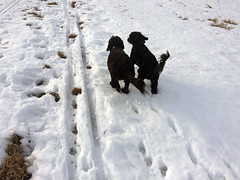
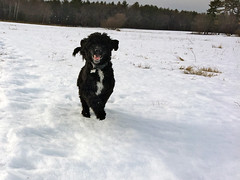







Wednesday, February 15, 2017
how do you store your seeds?
How do you store your vegetable seeds packets? The leftover seeds from one garden year that you want to use in future gardens. Or if you don't save any, why not?


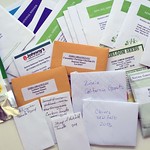
I've been keeping mine in a big plastic box at room temperature, 65-70F (18-21C), and as dry as I can by adding silica gel packets and keeping the top on.
After some reading, I see that the optimum humidity for most vegetable seeds is 20-25%. For legumes it's 44-50%. For temperature, a 10-degree reduction can double the life of my seeds. Optimum storage temperature of most vegetable seeds at home is 41F (5C) or lower, but frozen. It's also important to have a consistent temperature and humidity for storage.



A consistently cooler area I have is the garage. It's 50-60F (10-16C) and 40% humidity. I'll move my storage location out to there, give the beans an open box of their own. I'll keep adding the moisture absorbing packets to the other (closed) box. I'm also curious to check the humidity inside the closed box and see if it's any lower than the surrounding air.
Let me know any thoughts. I never looked into this until a reader commented that she refrigerated her seeds. My seeds last a long time (most about 6 years, some, like tomatoes, 10 years), but I wouldn't mind if they lasted even longer.
Here's an informative site that I found: WFLO Commodity Storage Manual: Vegetable Seeds. (WFLO is the World Food Logistics Org that dedicates itself to the proper handling and storage of perishable products and the development of systems and best practices for the safe, efficient, and reliable movement of food to the people of the world.)



I've been keeping mine in a big plastic box at room temperature, 65-70F (18-21C), and as dry as I can by adding silica gel packets and keeping the top on.
After some reading, I see that the optimum humidity for most vegetable seeds is 20-25%. For legumes it's 44-50%. For temperature, a 10-degree reduction can double the life of my seeds. Optimum storage temperature of most vegetable seeds at home is 41F (5C) or lower, but frozen. It's also important to have a consistent temperature and humidity for storage.



A consistently cooler area I have is the garage. It's 50-60F (10-16C) and 40% humidity. I'll move my storage location out to there, give the beans an open box of their own. I'll keep adding the moisture absorbing packets to the other (closed) box. I'm also curious to check the humidity inside the closed box and see if it's any lower than the surrounding air.
Let me know any thoughts. I never looked into this until a reader commented that she refrigerated her seeds. My seeds last a long time (most about 6 years, some, like tomatoes, 10 years), but I wouldn't mind if they lasted even longer.
Here's an informative site that I found: WFLO Commodity Storage Manual: Vegetable Seeds. (WFLO is the World Food Logistics Org that dedicates itself to the proper handling and storage of perishable products and the development of systems and best practices for the safe, efficient, and reliable movement of food to the people of the world.)
white house vegetables
I heard the new First Lady will keep the White House Vegetable Garden!! "The First Garden". I am so pleased that she values home gardening. I was impressed with the new President's statement to the Japanese Prime Minister:
"Both our countries' histories and cultures are steeped in the nurture and nature of gardening. Having knowledge of different cultures and customs is a wonderful way to learn and to explore. Gardening teaches us the fundamentals in care and the evolution of living things, all while inspiring us to nurture our minds and to relax and strengthen our bodies."Wow. That's great.
Monday, February 13, 2017
organizing seed packets
I'm so excited - all the seeds I ordered this year have arrived! Yeah! Almost as fun as planting them is putting them away in my seed organizer.

To store my seeds, I have a plastic box with a lid that holds standard-sized, heavy, 1-inch expanding envelopes. I have 20 of these envelopes. Each I've labelled with a type of vegetable. I have Bush Beans, Pole Beans, Roots (carrots, beets, etc), Flowers, Tomatoes, etc. Each seed packet goes into the appropriate folder.
I love the way this set-up works. It's easy to find my seeds and easy to return them to their spot.


Hannah, who runs the Vegetable Garden at Elm Bank (Wellesley MA) uses this approach and showed it to me. Rather than one box, she has at least ten of them!
I like to show my seed collection to gardeners and make the point that seeds last a long time. Most last at least 5 years. Tomato seeds can remain viable more than 10 years. A few seed types are short-lived, like carrots and onions. But it saves a LOT of money, and is fun(!), to save seeds year to year in an organized system. I enjoy building up a collection with lots of variety.
So now I have my seeds set, I've cleaned up some planting trays, my shelves and lights are up. The next step is getting my hands into dirt and planting. Ahh.... My calendar says to start onions and celeriac next week. But I think starting a week early can't hurt....

To store my seeds, I have a plastic box with a lid that holds standard-sized, heavy, 1-inch expanding envelopes. I have 20 of these envelopes. Each I've labelled with a type of vegetable. I have Bush Beans, Pole Beans, Roots (carrots, beets, etc), Flowers, Tomatoes, etc. Each seed packet goes into the appropriate folder.
I love the way this set-up works. It's easy to find my seeds and easy to return them to their spot.


Hannah, who runs the Vegetable Garden at Elm Bank (Wellesley MA) uses this approach and showed it to me. Rather than one box, she has at least ten of them!
I like to show my seed collection to gardeners and make the point that seeds last a long time. Most last at least 5 years. Tomato seeds can remain viable more than 10 years. A few seed types are short-lived, like carrots and onions. But it saves a LOT of money, and is fun(!), to save seeds year to year in an organized system. I enjoy building up a collection with lots of variety.
So now I have my seeds set, I've cleaned up some planting trays, my shelves and lights are up. The next step is getting my hands into dirt and planting. Ahh.... My calendar says to start onions and celeriac next week. But I think starting a week early can't hurt....
Sunday, February 12, 2017
app updates
I've been working on updates to Skippy's Calendar apps. It's really fun - like imagining a summer garden in the middle of winter! We'll have more plants and more seed sowing information added to both our Flower & Herb app and our Vegetable app. Updates will be available in a week or two (or three) to all purchases made now or later.
